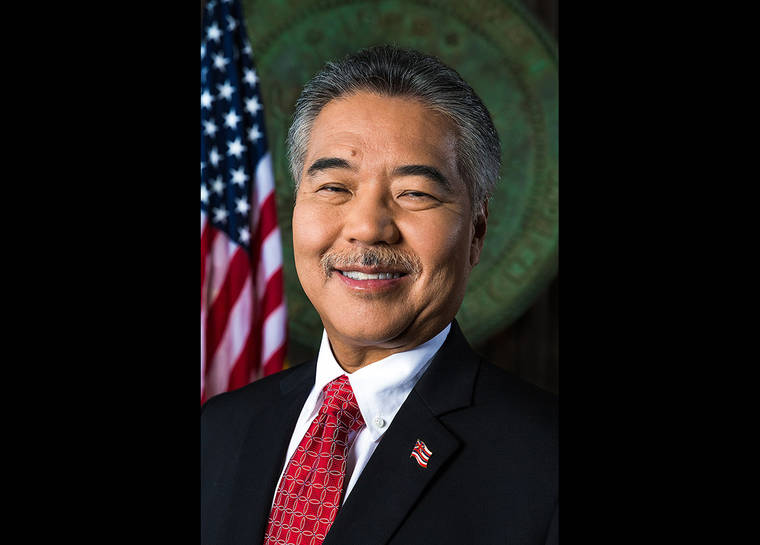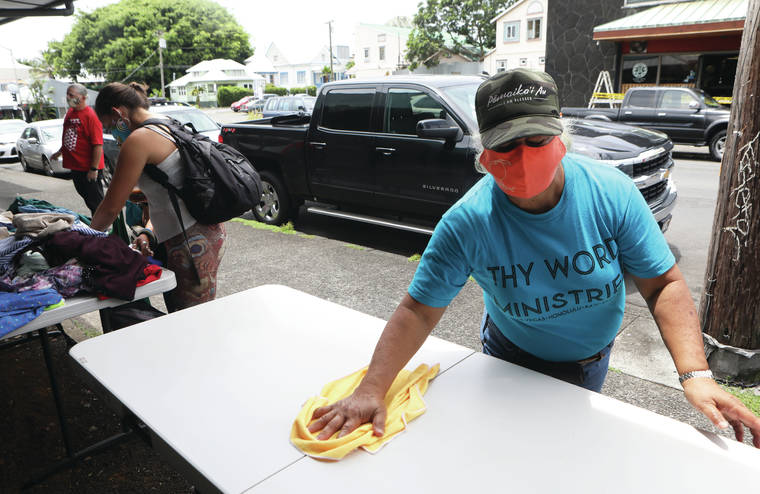Gov. David Ige and Honolulu Mayor Kirk Caldwell said in a joint media conference Tuesday that new gathering-size restrictions imposed in response to a recent spike in COVID-19 cases apply only to Oahu.
“I do want to make it clear that the neighbor islands continue in the ‘Act with Care’ phase of their reopening plans,” Ige said. “They have not seen the increased counts that we have seen here on Oahu.”
In addition, Ige said a plan to allow travelers who arrive in the state with a negative COVID-19 test result issued within 72-hours of departure has been pushed back from Sept. 1 “until Oct. 1 at the earliest.”
“We will continue to monitor the conditions here in Hawaii, as well as key markets on the mainland, to determine the appropriate start date of for the pre-travel testing program. We will be making that announcement in time so that the hospitality industry would have the time they need to staff up,” he said.
Ige also said a moratorium on evictions of tenants who fail to pay rent will continue at least through September.
Hawaii’s daily case count continues to be in the triple digits. Tuesday’s case count of 134 contains 124 new Oahu cases, seven in Maui County and three on Hawaii Island. Hawaii County Civil Defense reported 20 still-active cases and one hospitalization.
Despite the low Big Island numbers, Civil Defense Administrator Talmadge Magno expressed concern in his morning message, saying the island “has seen daily increases of positive cases over the past two weeks.”
“Most of these recent cases are not travel-related, which means the virus is being transmitted within the community,” Magno said.
While announcing restrictions for Oahu, Caldwell said his administration has “been struggling over the past four or five days on whether we use a scalpel or hammer to the spiking of COVID-19 on the Island of Oahu, but we’ve chosen a scalpel for now.”
As of today, the restrictions include “no social gatherings, indoors or outdoors, on the island of Oahu,” Caldwell said.
“By that, we mean no parties larger than five coming together, whether it be in a private or public setting,” he added.
The restrictions include face coverings required at all shopping malls, whether in a store or not, and at all in-person church or spiritual gatherings, with no singing or wind instruments.
No social gatherings will be permitted in businesses, and employers are being encouraged to reduce on-site employee numbers by using telecommuting or staggered work schedules.
“If you can work from home, we want you to work from home,” Caldwell said.
Oahu bars, beaches, parks and trails remain closed.
Caldwell took umbrage when asked if revenue is the reason gyms, a water park and the Honolulu Zoo are being allowed to remain open while “free outdoor spaces that are not associated with spread” are being closed.
“What we’ve done is try to control unregulated large outdoor gatherings. So gatherings outdoors, where there is no regulation in place, we’ve shut those down, to try to prevent further … spread,” he said. “As to whether we’re doing this for some business reason, I can’t believe that would even be asked. We’re doing this … to protect the health and safety of the people of Oahu.”
Infection counts continue to rise at Oahu Community Correctional Center as more testing of inmates and staff is being done there. The Department of Public Safety reported Tuesday 215 positive COVID-19 results among inmates, plus 34 infected staffers.
“I think we’ve got a challenge ahead of us in trying to figure out ways to decompress that situation, given the crowded situations in the prisons,” state Health Director Bruce Anderson said.
There were no positive test results as of Tuesday at Hawaii Community Correctional Center in Hilo.
With schools reopening for students this week, Ige called the public school system “an essential service,” and added it’s up to the individual school principals to decide whether teachers should be allowed to work from home “if they have the proper support.”
“Some students will be on campus because we cannot provide online learning for them,” he said. “And so, as required by federal and state laws, for … those students, we will be providing face-to-face (lessons) and programs, as required.”
Anderson said the U.S. Centers for Disease Control and Prevention “has come out with some pretty good guidance on schools across the country, and we’re leaning pretty heavily on what they’ve put together.”
“There are schools in the Northeast that have opened up. In fact, Florida has in-class learning as we speak; of course COVID is raging in Florida,” Anderson said. “And in most places, it’s thought that with good management, in-class learning — particularly for the younger kids — is possible, even with the virus circulating in the community. Here, of course, we feel a cautious approach is best, and I know that DOE is also wanting to be sure that their students are well-protected.”
Anderson said “a lot more work needs to be done” to ensure the state has “good guidance available for teachers, faculty, staff, parents and students” when in-person instruction begins.
That didn’t sit well with Corey Rosenlee, president of Hawaii State Teachers Association, who’s been pushing for a 100% remote-learning model until at least the end of the first quarter.
“We know this week that there were some campuses across the state where there were hundreds of students on campuses,” Rosenlee said. “And next week, the state is allowing vulnerable students to come on campus … that represents 57% of all students.”
Rosenlee said there are already 23 campuses with confirmed COVID-19 cases throughout the state, and HSTA is investigating other potential cases, including some on the Big Island. However, he added, the state has not even established suitable metrics for safely reopening schools.
Rosenlee also rebuked Anderson for using Florida as a possible model, given that, as of Tuesday, more than 46,000 children 17 or younger in Florida have contracted COVID-19.
Email John Burnett at jburnett@hawaiitribune-herald.com.













